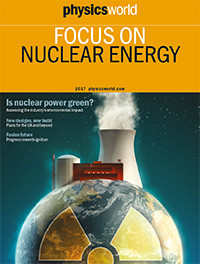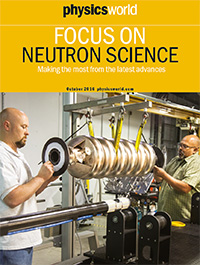Tag archives: focus issue
Following the ups and downs of nuclear energy
 By Margaret Harris
By Margaret Harris
If you’re finding the pace of geopolitical news a bit too rapid at the moment, spare a thought for physicists and engineers working in the nuclear energy sector.
Towards the end of last month, the venerable energy firm Westinghouse Electric issued a press release in which it proudly announced that its AP1000 reactor – a relatively new “passively safe” design in which the reactor core is kept cool without the need for powered pumps or other “active” equipment – had passed a major UK regulatory review. Ordinarily, this would be cause for celebration. The so-called “Generic Design Assessment” process takes years, and completing it helps pave the way for building AP1000s within the UK. An international partnership called NuGen has long hoped to do just that, on a site near Sellafield in north-west England, so in normal times, you might expect it to be celebrating, too.
The 2016 Physics World Focus on Neutron Science is out now
By Michael Banks
 Neutron scientists in Europe are facing a number of headwinds in the coming decade. One is the uncertainty caused by the recent UK vote to leave the European Union. Another is the impending closure of ageing reactors across the continent such as the Orphée reactor in Paris and the BER II reactor in Berlin, which could both shut down by 2020.
Neutron scientists in Europe are facing a number of headwinds in the coming decade. One is the uncertainty caused by the recent UK vote to leave the European Union. Another is the impending closure of ageing reactors across the continent such as the Orphée reactor in Paris and the BER II reactor in Berlin, which could both shut down by 2020.
A recent report by an expert group of researchers – the Neutron Landscape Group – paints a worrying challenge for neutron scientists. It forecasts that the continent’s supply of neutrons could drop by as much as a half over the next decade – a shortfall in capacity that is unlikely to be met by the upcoming European Spallation Source in Lund, Sweden.
That said, there are plans to help overcome the impending neutron gap, including proposals to plug it by building compact, specialist sources. Improvements to accelerator technology and instruments could also help by boosting the number of usable neutrons. Scientists at the US Spallation Neutron Source, for example, are pioneering a method to improve its proton beam energy using plasma processing, while the National Institute of Standards and Technology’s world-leading neutron microscope will soon open up to users.
View all posts by this author | View this author's profile